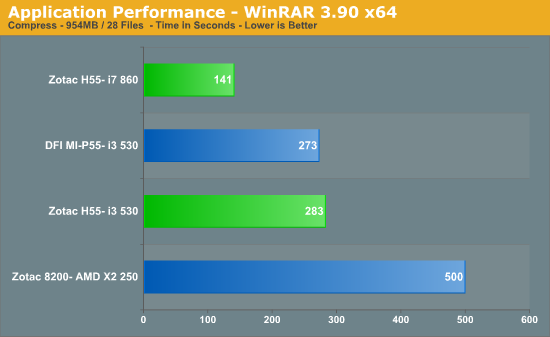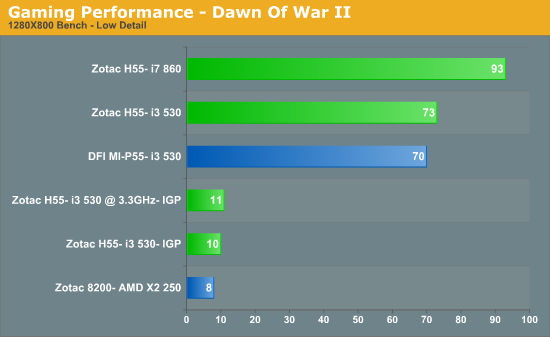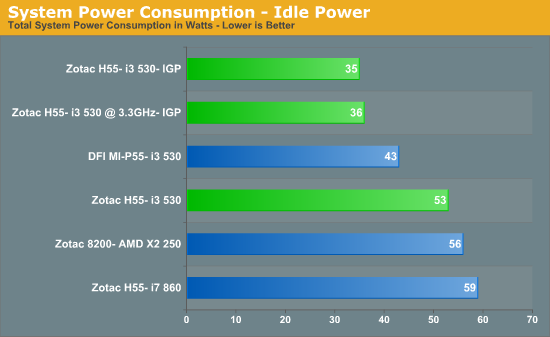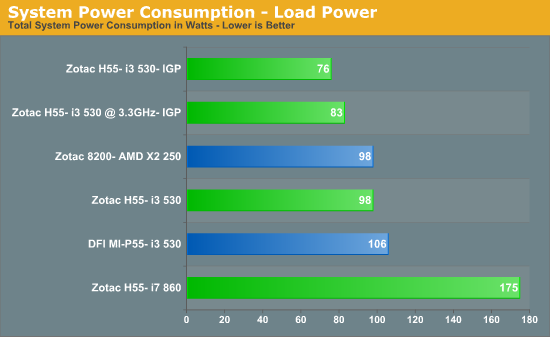Zotac H55-ITX Review - The World's First mini-ITX H55 Motherboard
by Joshua Youngberg on February 28, 2010 12:00 AM EST- Posted in
- Motherboards
Performance summary
App and Gaming Performance
We found that the H55-ITX performs comparably to the other H55/P55 motherboards on the market during system benchmarking.


Power Consumption
For our system power consumption tests we measure the watts being pulled out from the wall socket by the entire system. Keep in mind that power consumption at the wall can vary for a specific system based on the efficiency of the power supply being used. For these tests every power saving option in the BIOSes were turned on.


The Zotac H55-ITX put down some of the lowest idle power consumption numbers that I have ever recorded on a desktop. System consumption under 100% CPU load was very mild as well. Numbers this low would make the H55-ITX ideal for a system that is rarely shutdown, like a HTPC.
Audio Latency
During our battery of tests we also measure DPC latency. This will be of particular interest to the audiophiles of the world.

Overclocking
While testing the H55-ITX we decided to take a different turn for the overclocking segment. Instead of pushing the board to its limits in order to find its maximum frequencies we chose to find the perfect balance between speed and voltage. The fact that the VRM for CPU Vcore is very restricted and that the BIOS offered no adjustment for CPU VTT voltage helped point us in this direction.

To reach our final overclock on our i3 530 I simply raised the Bclock to 150, lowered the Vcore to the default, 1.20V, minus .025V and adjusted the Vdimm to 1.65V. 1.175V was the lowest Vcore we could use to maintain a 150 Bclock. All other available voltages were untouched. For system memory the timings were manually set to 9-9-9-24-72 and the frequency was set at 1500MHz. On a side note, I ran this system in a Silverstone SG06 and using the factory Intel heatsink core temperatures rarely got above 50 degrees Celsius.
We chose not to overclock the i7 860 to avoid any risk to the ZOTAC motherboards power circuitry. The H55-ITX simply wasn't designed to power a heavily overclocked quad core.










69 Comments
View All Comments
Duwelon - Monday, March 1, 2010 - link
Lol you're hopeless.Devo2007 - Sunday, February 28, 2010 - link
This might also make a decent candidate for a smaller Windows Home Server box as well (with something similar to the Acer Easyshare H340). Heck, if it weren't for the requirement of a CPU heatsink/fan, I'm pretty sure someone would find a way to swap out the board in the Acer with this.Orville - Sunday, February 28, 2010 - link
Joshua,I don't think I've read anything by you before. I guess you are new? You must be a gamer, though, because compute performance is mostly all you write about. On that subject, why doesn't Zotac spec the max power draw allowed for the CPU. I guess it must be at least 95 Watts? But why don't they stand up like a man and say what it is? There must be something rotten in Denmark. All you gamers would want at least 130 Watts, wouldn't you?
You must not be an HTPC guy because Blu-ray never showed up in this article, even once. Isn't Blu-ray (play from media, play from server, RIP and burn) the main thyme of HTPC? On that subject what are the key differences between the H55 and the N55 with respect to HTPC needs? Also, what NIC MAC/PHY does this board use? I don't think I saw that. Anyway, does the NIC support jumbo frames? If so, what size? I wouldn't buy this board for a either a media client or a media server without excellent jumbo frame support. Also, how does the Core i3 530 IGP work in an H55 motherboard setup. Somewhere I thought I read that HTPC was the realm of the N55?
I must confess that the power numbers you published here are very impressive. Imagine what they'd be if those hog HDDs you used were replaced by an SSD. Any idea how Zotac beats DFI so bad in power consumption. I mean 30 Watts less on 75 Watts total is pretty damn snazzy. How do they do that?
I'm waiting with baited breath for your response.
MadMan007 - Monday, March 1, 2010 - link
The DFI is a P55 board and so *must* have a graphics card, you are comparing IGP versus discrete card to get the 30W difference. It's actually an 8W difference (98 vs 106) when you look at discrete vs discrete.Lonyo - Monday, March 1, 2010 - link
I would assume an i3 CPU in a motherboard supporting it would be as capable at Bluray as an i3 CPU in a motherboard supporting it.Maybe it's a bit of an omission from this particular article, but AT has already done articles covering the i3/etc performance and included h264/Bluray playback numbers.
This is a motherboard review, and on this motherboard there is only sound which has any relevance to HTPC performance. Any commentary on Bluray playback ability would be more related to CPU/GPU performance, rather than the motherboard.
Most of the tests are just "this motherboard performs equally to other motherboards".
lowteckh - Sunday, February 28, 2010 - link
So where's the test for the wireless benchmark?And why not compare it to what everyone is probably most interested in - the LGA775 NV9300 board?
lowteckh - Sunday, February 28, 2010 - link
And where's the VGA port...? I wouldn't consider an adapter a port.mariush - Monday, March 1, 2010 - link
It has DVI to VGA adapter.Stokestack - Sunday, February 28, 2010 - link
A PS/2 keyboard connector? DVI?Why? Seems like a waste of space.
Given that you're OK with the on-board graphics (so you don't need a case big enough for full-length cards), what's the smallest case that would work with this thing?
CurseTheSky - Sunday, February 28, 2010 - link
PS/2 works on interrupts rather than polling. Even though USB keyboards feel "instant," there's actually a very short delay that can potentially cause problems. PS/2 eliminates that.Additionally, PS/2 supports full N-key rollover (allowing you to type / hold as many keys simultaneously as you wish without skipping any) while USB can only support a maximum of 6.
I personally use strictly USB devices, but PS/2 still has the advantage. Plus, I've had problems getting older OSes to install using a USB keyboard rather than PS/2.